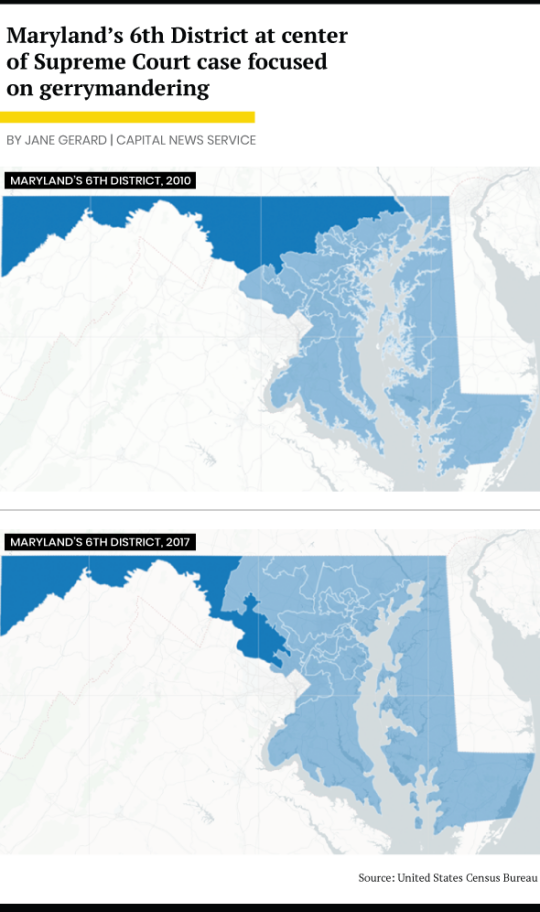
WASHINGTON (March 28, 2018)—Attorneys presented oral arguments Wednesday before the Supreme Court in a landmark case that challenges the constitutional limits of political redistricting in Maryland.
Benisek v. Lamone, the second gerrymandering case the high court has heard this term, focuses on whether redrawing district lines in favor of one party is a violation of the First Amendment.
Michael B. Kimberly, representing O. John Benisek, a resident of Washington County, argued the partisan gerrymandering that occurred in Maryland's 6th District under then-Gov. Martin O'Malley in 2011 was a violation of the First Amendment due to the additional challenges created by shifting districts for voters.
"The evidence is unequivocal," Kimberly told the justices. "It's deliberately making it more difficult for particular citizens to achieve electoral success because their views are disapproved by those in power."
In 2011, O'Malley created the Governor's Redistricting Advisory Committee (GRAC) to redraw the congressional and state legislative districts in Maryland. A new map was created, passed both the Maryland House and Senate, and was signed by O'Malley.
Before the redistricting, Maryland Democrats controlled six of the state's eight U.S. House districts. After the election following the new map, the Democrats controlled seven. Republicans argue the partisan redistricting caused irreparable damage to voters in the new district.
Kimberly went on to argue that "Governor O'Malley and others involved in the redistricting have candidly acknowledged their intent to dilute Republican votes in the 6th District to prevent Republican voters there from reelecting Congressman Roscoe Bartlett."
"Given their evidence, (the appellants) certainly have enough to go to a jury on that question," Justice Sonia Sotomayor said.
"Government officials may not single out particular individuals for disfavored treatment on the basis of the views that they have expressed at the ballot box in prior elections," Kimberly argued.
Some justices questioned whether voters had truly been harmed by the redistricting.
Chief Justice John Roberts called the length of time between the redistricting and the oral arguments into question.
"To let go the elections in 2012, 2014, and 2016, suggests that maybe 2018, you're not going to be irreparably harmed in a broader sense," he said. "If you've been willing to accept that harm in three different cycles, I don't know if we should get concerned about irreparable harm for one more."
Many justices questioned the intent of the redistricting, suggesting O'Malley's reason for redistricting was unconstitutional.
"The effects were exactly what the intent would suggest," Justice Elena Kagan said. "A long-standing Republican incumbent is unseated by a Democratic newcomer, who withstands a wave election, who prevails three straight times. I mean, it appears that the Maryland legislature got exactly what it intended, which was you took … a safe Republican district, and made it into not the safest of Democratic districts, but a pretty safe one. … I mean, how much more evidence of partisan intent could we need?"
Steven Marshall Sullivan, representing Linda H. Lamone, Maryland's elections administrator, insisted otherwise: "(The 6th District) is not safe. It was judged competitive."
Sullivan said that 20 percent of voters in the 6th District are registered as independents. The result is that neither the Republicans nor the Democrats make up a majority there, he said.
"The independent vote is critical because, in the first election, the Democrat won more of the independent vote than the Republican," Sullivan said. "The redistricting lines couldn't have caused that to happen. That happened because of the views of those voters and the strength of that candidate."
"What effect does the fact that this map was subsequently approved by the people themselves have when we're trying to determine intent?" Justice Neil Gorsuch asked.
Ginsburg compared the current case to an historic racial gerrymandering case from 1995, Miller v. Johnson, in which the court struck down districts solely created based on race, known as "max-black" districts.
"It seems to me that what we have here is 'max-Democratic' (per district)" she said. "If 'max-black' was no good, why should 'max-Democratic" be okay?"
Sullivan responded that the historic 'max-black' districts were "drawn from a history of exclusion of African Americans from our political process, something that Republicans can hardly claim," because their party currently controls both the federal and state governments.
Earlier this term, the Supreme Court heard the Gill v. Whitford case from Wisconsin regarding gerrymandering. In January, the Supreme Court temporarily blocked a redistricting order from a lower court in North Carolina.
Justice Stephen Breyer suggested waiting until next term, at which point those two cases and the Maryland case could be heard together.
"It seems like a pretty clear violation of the Constitution in some form to have deliberate, extreme gerrymandering," Breyer said of the Maryland map. "But is there a practical remedy that won't get judges involved in dozens and dozens and dozens of very important political decisions?"
Courts have previously treated challenges to political redistricting as a "nonjusticiable 'political question,' based on the lack of a determinate, judicially enforceable standard to judge political gerrymanders," according to the Preview of the United States Supreme Court Cases.


